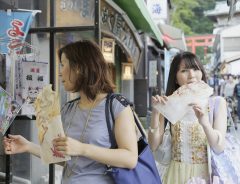- Tags:
- anti-smoking / Manners / Posters / smoking / smoking ban
Related Article
-

Rigid Rules Of Japanese Drinking Parties Broken Up By A Special A.I. Powered Fan–And Delicious Beer[PR]
-

Japanese schoolgirl poster hides a dark but important message behind smile
-

The ultimate penalty for inconsiderate owners who don’t pick up their pet’s poo [manga]
-

Kamakura Passes Ordinance Against Eating On The Go: Ill-Mannered Tourists To Blame
-

Photo Posted Online Encompasses One Reason Everyone Loves Japanese Politeness
-

Los Angeles Metro Turns To J-Pop And Anime Girls To Teach Train Manners



In common with other countries, the number of smokers in Japan is in steady decline. Currently, around 28% of Japanese men and 9% of Japanese women smoke. This is a considerable drop from its peak in 1966, when the proportion of male smokers stood at 83%.
Photo by George Lloyd
Unlike other countries’ anti-smoking campaigns, Japan’s has focused on outdoor, rather than indoor smoking. Most Tokyo wards have designated smoking areas on the street and smokers caught smoking outside these areas can be fined.
Photo by George Lloyd
In 2008, Japan Tobacco commissioned a series of ‘smoking manners’ posters, instructing smokers in smoking etiquette. Here’s a selection of JT’s posters on display in the designated smoking spaces around Tokyo.
Photo by George Lloyd
Rather than the dangers of second-hand smoke, Japan’s anti-smoking campaign has focused on the litter created by discarded cigarette butts and the risk of burning passers-by. To avoid littering, many smokers even carry portable ashtrays.
Photo by George Lloyd
This light-touch regulation reflects the power of the tobacco lobby. Until 1985, the tobacco industry was a government-run monopoly. The government still owns one-third of Japan Tobacco, which may explain why health warnings are low-key and cigarettes are still relatively cheap.
Photo by George Lloyd
Some wealthier wards, such as Shinjuku and Shibuya, have banned smoking in public outright. However, most coffee shops and restaurants have designated, airconditioned smoking cubicles.
Photo by George Lloyd
In anticipation of the arrival of thousands of non-smoking foreigners for the 2020 Olympics (postponed until 2021), a new law prohibiting indoor smoking came into effect in April 2020. But indoor smoking cubicles will be unaffected.